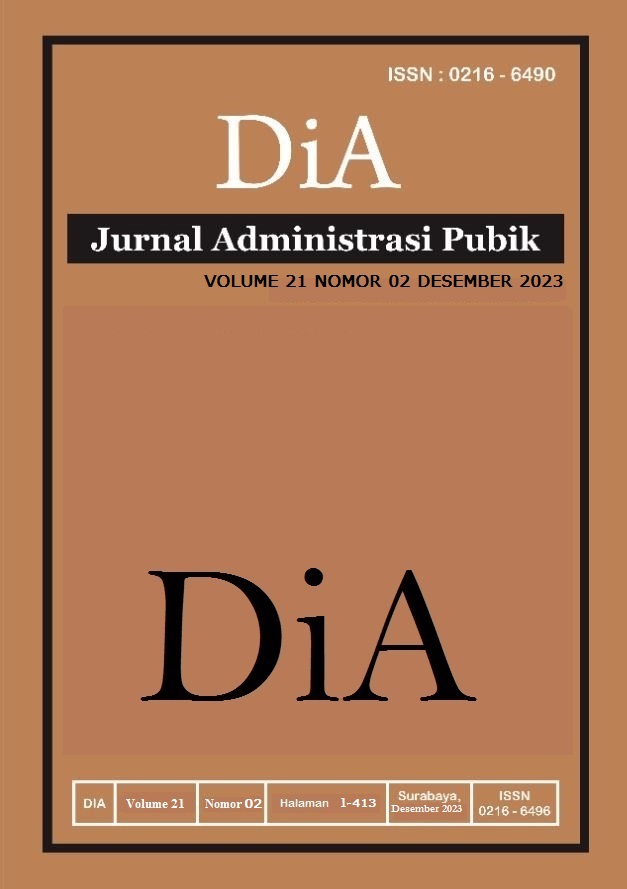EFFECTIVENESS OF THE EXPANSION PROGRAM OF EMPLOYMENT OPPORTUNITY FOR UNEMPLOYMENT PREVENTION OF SUKABUMI DISTRICT
DOI:
https://doi.org/10.30996/dia.v21i02.8044Keywords:
Effectiveness, Labor, Expansion of employment opportunities programAbstract
The purpose of this study to determine the effectiveness of the expansion of employment opportunities program against unemployment reduction in Sukabumi. The method used is qualitative method with descriptive approach. Data collection using observation techniques, interviews, and documentation. Data analysis using Flow model Method and Data Validation using triangulation technique. This study uses the theory of program effectiveness from Sutrisno with 5 indicators of program effectiveness, namely program understanding, target accuracy, timeliness, achievement of goals, and taking real research results show the effectiveness of the expansion of Employment Opportunities Program Against Unemployment in Sukabumi runs well where the dimension of understanding the independent labor program. Program runs skill training through the P2KSS program so as to support the achievement of targets. On the dimension of the accuracy of the target where the independent labor program according to the target where targeting housewives. In imensi keteapatan socialization time will be quite effective independent work program because it has done socialization as much as 2 times face to face. In the dimension of the program where the independent labor program spreads widely to all levels of society. And in the dimension of real decision where Disnakertrans provide facilities and assistance to the community and also training has been implemented.
Downloads
References
Arikunto, S. (2016). Prosedur Penelitian Suatu Pendekatan Praktik. Rineka Cipta.
Budiani, N. W. (2007). Efektivitas Program Penanggulangan Pengangguran.
Creswell, J. W. (2013). Research Design: Qualitative, Quantitative, and Mixed Methods Approaches. 4th Edition. Sage Publications, Inc.
Dunn, W. N. (1999). Pengantar Analisis Kebijakan Publik. Gajah Mada University Press.
Jonathan, G. (2017). EFEKTIVITAS PENGGUNAAN DANA DESA DALAM PENINGKATAN PEMBANGUNAN. Jurnal Eksekutif, 2(2).
Mahmudi. (2013). Manajemen Kinerja Sektor Publik. Sekolah Tinggi ilmu Manajemen YKPN.
Makmur. (2015). Efektivitas Kebijakan Kelembangaan Pengawasan. Refika Aditama.
Mardiasmo. (2017). Efisiensi dan Efektivitas. Andy.
Milles, A., & Huberman, A. (2014). nalisis Data Kualitatif: Buku Sumber Tentang Metode-Metode baru. UI-Press.
Moleong, L. J. (2018). Metodologi Penelitian Kualitatif. PT. Remaja Rosdakarya.
Nawawi, H. (2016). Manajemen Sumber Daya Manusia. Gajah Mada Press.
Nugroho, R. (2012). Public Polict. Kompas Gramedia.
Siagian, S. P. (2015). Manajemen Sumber Daya Manusia. PT. Bumi Akarsa.
Sugiyono. (2018). Metode Penelitian Kuantitatif, Kualitatif, dan R&D. Alfabeta.
Sulistiarini, W., & -, T. (2021). EFFECTIVENESS OF WASTE MANAGEMENT AS A SOURCE OF ELECTRICAL ENERGY IN TPA BENOWO, SURABAYA CITY. DIA: Jurnal Administrasi Publik, 19(1), 85–103. https://doi.org/10.30996/dia.v19i1.4920
Sutrisno, E. (2010). Manajemen Sumber Daya Manusia. Kencana.
Widodo, J. (2011). Analisis Kebijakan Publik. Bayumedia.
Downloads
Published
How to Cite
Issue
Section
License
The DiA journal allows authors to retain the copyright of their papers without limitation. Authors may grant publishers non-exclusive publishing rights to publish articles. Granting first publishing rights to publishers also qualifies as unlimited copyright (because there are no restrictions imposed by publishers on author copyright).






